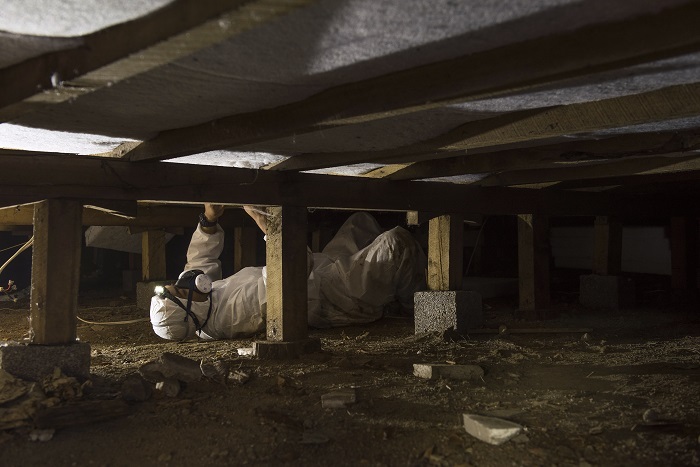31 January 2023
Working underfloor is not for the faint-hearted. Our underfloor insulation heroes are used to it so here are some tips for flooded properties to keep you safe and guide you.
Underfloor areas are full of hazards at the best of times - after a flood even greater care is needed as the flood waters can carry hazardous debris, bacteria and disease.
Here are some tips from the underfloor experts at Brightr about safely working underfloor, evaluating the condition of your underfloor insulation and if necessary removing it.
Safety First - PPE & Power Off
The conditions underfloor mean that you need good PPE to keep you safe from the conditions underflooreven more so with flood contamination. Our team use:
- Seam Sealed Coveralls. A fully sealed coverall should be worn to ensure hazardous substances don't come into contact with your skin or clothing. These should be disposed of after use. This is due to the risk of sewerage, industrial waste, petrochemicals and other household contaminants.
- Gloves: Nails, screws staples, broken glass, splinters - we've seen it all. Protect yourself.
- Respirator or Mask: There's alot of dust and airborne particles underfloor and working down there can disturb even more material. A full-face respirator mask is best.
- Saftey Goggles: If not wearing a full face respirator, safety goggles are essential. Airborn contaminants that get in your eyes can be a severe irritant. Also if removing stapled insulation there is a risk of getting a staple in the eye.
- Headlamp & torch: A head lamp will ensure you have general as well as task related hands-free light. A torch may be needed for longer directional light.
Why Power Off?
Before you even start underfloor you need to turn your power off for two reasons:
- Foil insulation - we have commonly come across situations where the foil is "live" with the foil either originally or over time coming into contact with the underfloor electrical wires. If you are working anywhere near underfloor foil insulation - switch off the power.
- Any stapled insulation. If you are removing, working near or installing stapled insulation - there is again a risk that the staple may pierce a wire or move to make contact with a wire and give you an electric shock.
Remember - even with power off the main electrical cable from the street to the house is always live.
Clear Visible Hazards & Debris
After the subfloor water has been drained remove any dirt, rubbish and other debris left behind by floodwater. Take care removing any obvious sharp or hazardous objects and excercise caution assuming there are small unseen sharp objects as well.
Removing the silt and debris is important as it will slow the drying process.
Assessing Flooded insulation
The condition of your insulation post-flood and its need to be replaced depends on the type of insulation and the level of flooding you've had.
Flooding that didn't reach the insulation
- Polyester and Polystyrene: If the flood water did not reach as high as the insulation then these two materials will work effectively once dry which shouldn't take too long.
- Fibreglass/Glasswool: No insulation material is designed to get wet but fibreglass can be adversely and permanently affected by moisture. "Even if dried out, it will not recover its original thickness and therefore the effectiveness of the insulation will be significantly reduced." Moisture/water "trapped in the insulation batts can also cause mould growth." Source: Bradfordinsulation.com.au
Note that insulation affected by damp conditions but not contaminated by flood waters may not be covered by insurance.
Flooding that covered the insulation
Any underfloor insulation will need to be removed and replaced as it will be unsanitary if floodwater has reached it and will smell and be a health hazard.
Note that it is illegal to repair or replace any foil insulation that is contaminated. It needs to be replaced with a code-compliant insulation.
For more information on Restoring your home after Flood Damage we recommend you read this BRANZ Bulletin on the topic. BRANZ is the Building REsearch Association of New Zealand.
Need more Help?
If it is some time till your insurance assessor can visit, and if you know your insulation needs replacing - book in with our experienced team who can help so that you're ready to go once insured replacement is confirmed.

A Brightr team member installing Mammoth polyester sections. Note: this is not in a flood-affected area which is why he is not wearing a full face mask.